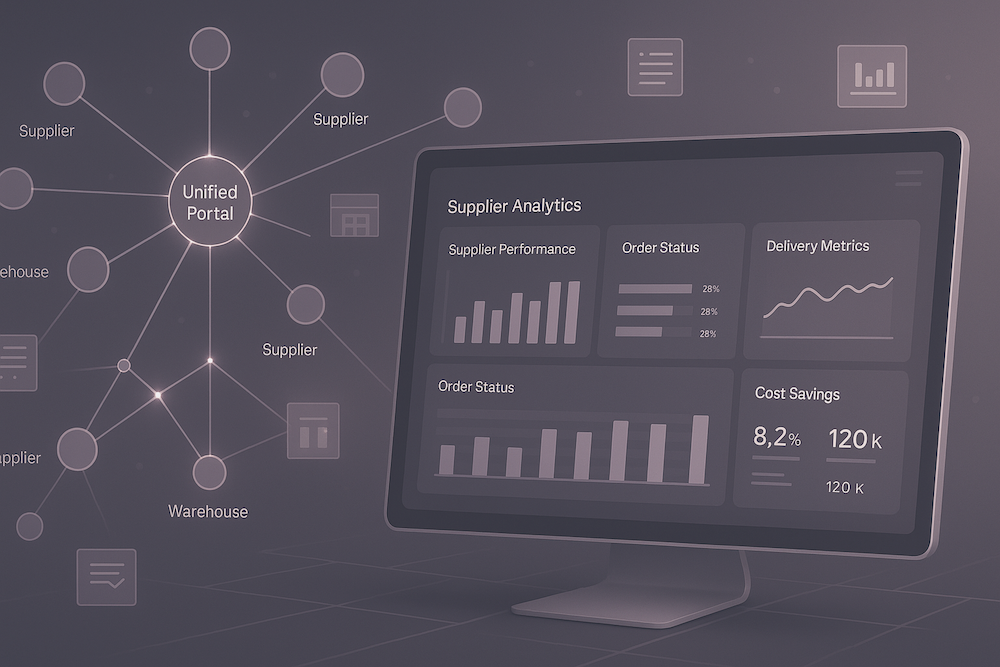In today’s rapidly evolving business landscape, efficient supply chain management is paramount for businesses, especially for small to medium-sized enterprises (SMBs) in retail, supply, and logistics. Therefore, a unified supplier portal for SMBs is no longer a luxury but a strategic imperative. We’ll delve into the significant return on investment (ROI) that a centralized supplier portal can offer, streamlining operations, reducing costs, and fostering stronger supplier relationships.
The Challenges of Traditional Supplier Management
Many small to medium-sized businesses still grapple with outdated, manual processes for managing their supplier relationships. This often involves a fragmented approach with disparate communication channels, manual data entry and a lack of real-time visibility. In turn, these inefficiencies can lead to a host of problems, including:
- Increased Operational Costs: Manual processes are time-consuming and error-prone, leading to higher labor costs and the need for rework.
- Poor Communication and Collaboration: Fragmented communication channels can result in misunderstandings and delays between businesses and their suppliers.
- Lack of Data Accuracy and Visibility: Without a centralized system, tracking supplier performance, order statuses and inventory levels becomes challenging, leading to inaccurate forecasting and decision-making.
- Compliance Risks: Manual record-keeping and a lack of standardized processes can increase the risk of non-compliance with regulatory requirements.
The Power of a Unified Supplier Portal for SMBs
A unified supplier portal addresses these challenges head-on by providing a centralized, collaborative platform for all supplier-related activities. This digital transformation offers a multitude of benefits that directly contribute to a positive ROI:
- Streamlined Onboarding and Management: Automate supplier registration, qualification and information management, reducing administrative burden and accelerating time-to-value.
- Improved Communication and Collaboration: Provide a single, secure channel for real-time communication, document sharing and issue resolution, fostering stronger supplier relationships.
- Enhanced Data Accuracy and Visibility: Centralize all supplier data, including contracts, performance metrics, and order history, for comprehensive insights and informed decision-making.
- Reduced Costs and Increased Efficiency: Automate manual tasks, minimize errors, and optimize workflows, leading to significant cost savings in labor and administrative overhead.
- Better Risk Management: Gain greater visibility into supplier performance, compliance and potential disruptions, enabling proactive risk mitigation and business continuity.
Key Features to Look for in a Unified Supplier Portal
When choosing a unified supplier portal, look for key features that align with your business needs and long-term goals:
- Centralized Supplier Database: A comprehensive repository for all supplier information, including contact details, contracts, certifications and performance history.
- Self-Service Capabilities: Suppliers manage their own profiles, submit invoices, track payment status, etc., reducing administrative burden.
- Automated Workflows: Routine tasks are automated, improving efficiency and reducing manual effort.
- Performance Monitoring and Reporting: Track key supplier performance indicators (KPIs), generate customizable reports and identify areas for improvement.
- Integration Capabilities: Seamlessly integrate with existing ERP, procurement and accounting systems to ensure data consistency and streamline operations.
- Scalability and Flexibility: A platform that can grow with your business, accommodating an increasing number of suppliers, users and data.
Conclusion
Investing in a unified supplier portal for small to medium-sized businesses is a strategic decision that can yield significant returns. By centralizing supplier management, automating key processes and fostering collaboration, you can unlock new levels of efficiency, reduce costs and drive sustainable growth. The benefits are clear: a unified supplier portal is an essential tool for any business looking to thrive in today’s competitive landscape.
FAQs
A unified supplier portal is a centralized online platform that allows businesses to manage all interactions and activities with their suppliers. It provides a single, secure space for communication, data exchange, and collaboration, streamlining processes from onboarding to payment.
A unified supplier portal helps small to medium-sized businesses reduce operational costs, improve data accuracy, and enhance supplier relationships. By automating manual tasks and providing real-time visibility into the supply chain, it enables more efficient and strategic decision-making.
Key features to look for include a centralized supplier database, self-service capabilities for suppliers, automated workflows for tasks like purchase orders and invoicing, performance monitoring and reporting tools, and seamless integration with existing ERP and accounting systems.

Leave a Reply